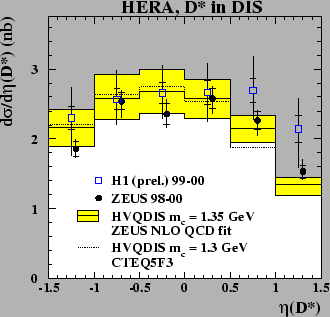 |
 |
ZEUS and H1 have measured the open-charm contribution
![]() to the proton structure function
to the proton structure function ![]() .
In fig.24 the structure function
.
In fig.24 the structure function
![]() is shown as a function of
is shown as a function of ![]() in different bins of
in different bins of ![]() .
The data from H1 [5,43,46] and ZEUS
[15,16] are found to be in good agreement with each
other and with the prediction in next-to-leading order as taken from a
recent ZEUS NLO fit [68].
The data rise with increasing
.
The data from H1 [5,43,46] and ZEUS
[15,16] are found to be in good agreement with each
other and with the prediction in next-to-leading order as taken from a
recent ZEUS NLO fit [68].
The data rise with increasing ![]() , the rise becoming steeper at
lower
, the rise becoming steeper at
lower ![]() , demonstrating the property of scaling violations in charm production.
The uncertainty
on the theoretical prediction comes from the uncertainty of the PDF fit
to the inclusive data from which the charm component is calculated dynamically, i.e.in the
massive scheme.
At small and moderate
, demonstrating the property of scaling violations in charm production.
The uncertainty
on the theoretical prediction comes from the uncertainty of the PDF fit
to the inclusive data from which the charm component is calculated dynamically, i.e.in the
massive scheme.
At small and moderate ![]() , the
uncertainty in the data is comparable to the PDF uncertainty shown.
This implies that the double-differential cross sections could be
used as an additional constraint on the gluon density in the proton.
At moderate
, the
uncertainty in the data is comparable to the PDF uncertainty shown.
This implies that the double-differential cross sections could be
used as an additional constraint on the gluon density in the proton.
At moderate ![]() the most precise measurement of
the most precise measurement of
![]() [46] is
achieved by evaluation of the charm lifetime distribution in an inclusive
event sample using the H1 silicon vertex detector. Details of the
analysis method and results are given in sections 5.5.2 and
6.2.2.
[46] is
achieved by evaluation of the charm lifetime distribution in an inclusive
event sample using the H1 silicon vertex detector. Details of the
analysis method and results are given in sections 5.5.2 and
6.2.2.
 |